River Stour Enhancement
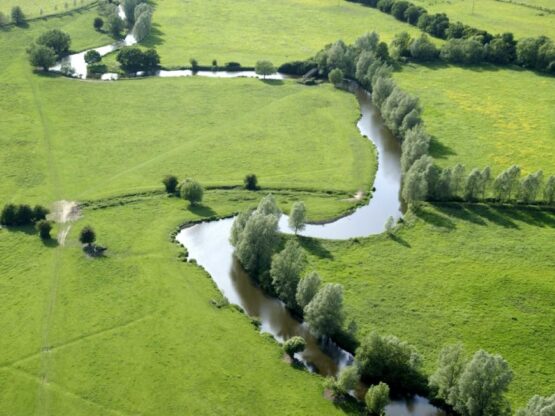
The Dedham Vale National Landscape and Stour Valley Project and the Environment Agency (EA) are working together on a partnership project to address Water Framework Directive (WFD) targets in the Stour catchment.
The EA and the Dedham Vale have worked successfully on projects in the past and it was identified in 2012 that there was a good opportunity to set up a partnership project that would focus on improving the ecological status of the River Stour and its tributaries.
The partnership project has benefited from various sources of funding to date.
The project is managed Peter Cosgrove, River Stour Project Officer, who has overseen the delivery of numerous successful river conservation initiatives across the Dedham Vale National Landscape and Stour Valley Project area.
The River Stour Enhancement Project aims to strike a balance between protecting the diverse wildlife living in and around the River Stour and its tributaries whilst providing access for people to enjoy.
The project is governed by the River Stour Enhancement Project Steering Group which includes the National Landscape Manager, Simon Amstutz, the River Stour Project Officer and the Environment Agency's Catchment Delivery Manager for Suffolk, Will Akast.
Project Aims and Objectives
The main aims and outcomes of the collaborative agreement for the project are:
- To develop a suite of river restoration projects by working with landowners, land managers, local authorities, conservation organisations, statutory bodies and volunteers to address WFD issues including morphology, diffuse pollution from agriculture and fish failures.
- To build strong relations with landowners, land managers, local community groups and conservation organisations in order to raise awareness of WFD issues and to encourage engagement in catchment restoration projects.
- To set up a Local Action Group in the Stour Valley to tackle the issue of non-native invasive species in the catchment with a specific focus on non-native invasive plants (NNIP). This involves raising awareness, undertaking NNIP surveys and organising control / eradication work.
- To bid for funding from a range of sources including the Water Environment Improvement Fund, Essex and Suffolk Water Branch Out Fund and Water Environment Grant.
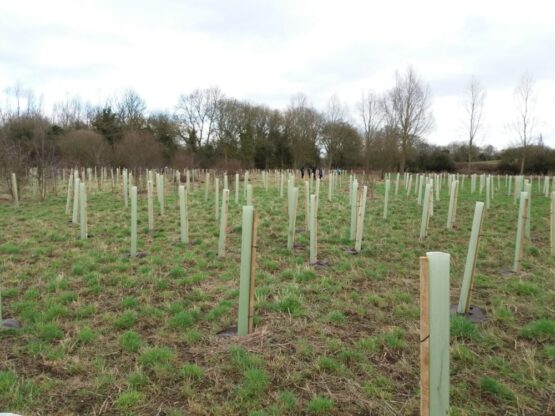
Environment Agency funding has been used to undertake projects to re-instate and create important features in the river such as riffles, pools, berms and backwaters that are crucial for a range of different fish species and other aquatic life.
In October 2014 and October 2016, large scale habitat restoration projects were completed which aimed to improve the in-channel habitat for spawning fish, increase floodplain connectivity to benefit wetland flora and fauna.
In 2016, the River Stour Enhancement Project received funding of £3,500 from the Essex and Suffolk Water Branch Out Fund which funded the planting of 500 riverside trees at 23 sites across the Stour Valley.
Since 2016, 9,000 riparian trees and shrubs have been planted in the the River Stour catchment.
Essex and Suffolk Stour Valley Ten Rivers Project
The Dedham Vale National Landscape and Stour Valley Project is delighted to have secured £71,600 of Water Environment Grant (WEG) funding in February 2019. The WEG scheme provides funding to improve the water environment in rural England.
The funding comes from the European Agricultural Fund for Rural Development (EAFRD) and is part of the Rural Development Programme for England (RDPE). The grant money will help to fund river projects in the Stour Valley up until the end of March 2021. The Essex and Suffolk Stour Valley Ten Rivers Project will help to address problems in 10 rivers (13 water bodies) identified in the Water Framework Directive assessment of the River Stour and its tributaries.
The problems include rising water temperatures (due to climate change, lack of riparian trees and low flows); sedimentation; a lack of habitats for fish, invertebrates and flora; surface runoff and the spread of two non-native invasive species (Giant Hogweed and Himalayan Balsam).
These problems will be addressed through the wide-scale planting of riparian trees at multiple locations; the formation of new river habitats through the creation of backwaters, berms, flow deflectors and floodplain re-connections, along with awareness raising on how to tackle these problems amongst the riparian landowner community.
Project Aims and Objectives
The three main objectives of the WEG funded project are:
- To plant 5,000 riverside trees on 11 waterbodies, totalling 7,627m of riverbank in the River Stour Catchment by March 2021.
- To enhance 2,333m of in-channel and riparian habitats on two waterbodies through the creation of 57 features (backwaters, berms, flow deflectors and floodplain re-connections) by March 2021.
- To carry out monitoring and control of Giant Hogweed and Himalayan Balsam on 17,533m of riverbank on 9 waterbodies annually until March 2021.
The Essex and Suffolk Stour Valley Ten Rivers Project will lead to significant improvements for numerous ecosystem functions. The insertion of woody debris will help to increase local flow velocities, thereby helping to keep areas of gravel bed clean of sediment and suitable for fish spawning. It will also provide cover and habitat for invertebrates and fish, including areas of slack water during times of high flows.
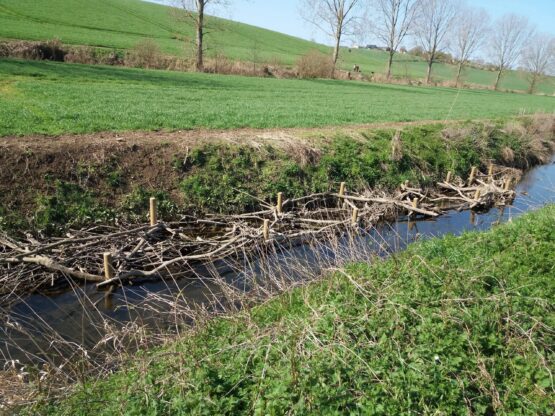
The Essex and Suffolk Stour Valley Ten Rivers Project will lead to significant improvements for numerous ecosystem functions.
The insertion of woody debris will help to increase local flow velocities, thereby helping to keep areas of gravel bed clean of sediment and suitable for fish spawning.
It will also provide cover and habitat for invertebrates and fish, including areas of slack water during times of high flows.
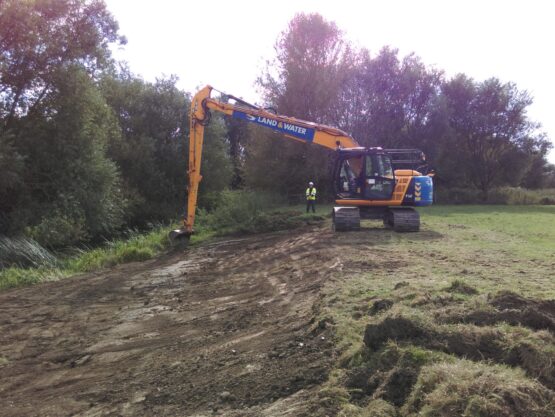
The creation of berms will help the river channel return to a more appropriate dimension, narrowing the river and increasing sinuosity, thereby encouraging a more varied and natural flow regime.
The berms will also provide a "trap" for sediment moving through the river system and provide habitat for plant species that rely on the damp margins of watercourses.
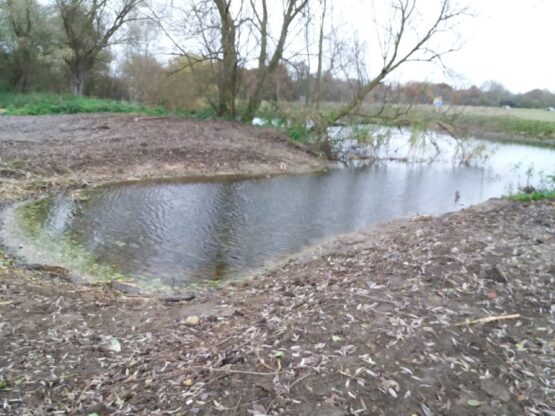
The creation of backwaters will provide sheltered conditions away from the main flow of water in the river. This is important for many fish populations during flood conditions as they provide shelter from the full force of water.
In summer, the shallow depth of backwaters allows the water to warm and provides ideal conditions for the rapid development of fish fry.

The planting of riparian trees will provide physical habitat diversity that in turn supports an array of animal and plant species. Trees provide underwater root systems of value to fish and invertebrates.
They help to stabilise river banks, create habitat and protect them from erosion, and will also help to shade and moderate extremes in water temperature.
Parts of the floodplain will be "wetted up" through re-connections with the river. This will help to improve their biodiversity value, for example, by increasing their attractiveness to wintering wildfowl. Increasing the ability of the floodplain to store floodwaters can also have benefits in terms of reducing flood risk to downstream communities.
The project is now complete and you can read all about the progress that was made.
